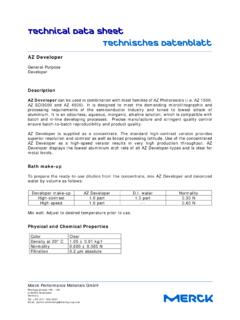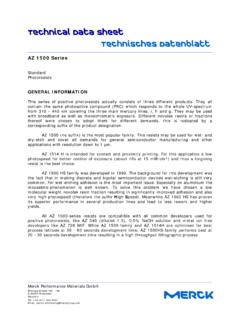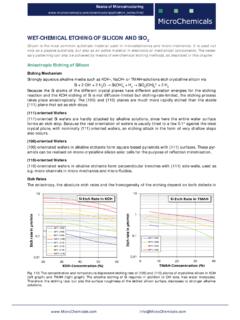Transcription of AZ nLOF 20xx Negative Resist - MicroChemicals
1 MicroChemicals GmbH Ulm - AAAZZZ nnnLLLOOOFFF 222000xxxxxx NNNeeegggaaatttiiivvveee RRReeesssiiisssttt .. complement Information for Processing revised 2005-11-07 n General Information AZ nlof 20xx is a family of Negative resists, with the exposed Resist remaining on the substrate after development. The adjustable undercut ( Negative profile), together with its very high stability against ther-mal softening, makes AZ nlof 20xx best-suited for lift-off as well as any other processes requiring a thermal stable Resist profile even at high temperatures. Similarities and differences to other AZ photo re-sists are described on the basis of the following process steps: The AZ nlof 20xx Resist film thickness attained by spincoating at 3000 rpm corresponds to the last two digits xx ( 70 for AZ nlof 2070) in 100 nm units ( m for AZ nlof 2070). A softbake of 100 C (hotplate) for approx. 1 minute per m Resist film thickness is recommended.
2 A rehydration (delay for H2O-resorption) is NOT required. AZ nlof 20xx is only i-line sensitive, the exposure dose given in the technical data sheet corre-sponds only to the i-line (365 nm) part of the illumination source. Therefore, it has to be considered to which part of the UV spectrum the calibration of the mask aligner refers (broadband or i-line). The post exposure bake (PEB) performed after exposure on a hotplate at 110 C for approx. 1 minute is NOT optional, but necessary for the cross-linking of the exposed Resist . A delay between exposure and this PEB is NOT required, since no N2 (which would have to outgas) is created during exposure of AZ nlof 20xx . The recommended developer is AZ 826mif. Using other developers may prevent development (start) due to a (accidentally thermal or optical induced) partial crosslinked Resist surface. n Optical Properties After softbake, AZ nlof 20xx has an i-line (365 nm) absorption coefficient of approx. m-1 (fig.)
3 Bot-tom-left). In contrast to AZ positive resists, this value will NOT significantly change during exposure, since AZ nlof does NOT bleach. Therefore, the through-exposure of thick or very thick films is limited: As the figure bottom-right shows, after passing 10 m Resist film, the 365 nm light intensity is dropped to 1% of the incident light intensity, which is not enough for sufficient cross-linking applying reasonable long exposure times. However, Negative resists do not generally require through-exposure; the processing of 10-20 m Resist films is possible. After exposure, the optical absorption both at very low wavelengths (<330 nm) and in the short-wavelength visible spectral range increases. The latter explains the yellowish colouring of the Resist film (visible on transparent substrates) after exposure. A moderate Resist swelling of the exposed areas during PEB can also be observed: At the elevated temperatures, remaining solvent evaporates much faster from the unexposed Resist parts (thus thinning the Resist ), while the cross-linked exposed Resist is far less per-meable for evaporating solvent.
4 00,10,20,30,40,50,60,70,8300350400450500 Wavelength (nm)Absorption coeffizient ( m-1)_aftersoftbakecompletelyexposedafter postexposurebake 110 C0,111010002468101214 Distance from Resist Surface ( m)Normalized i-line (365 nm)__ Intensity (%) MicroChemicals GmbH Ulm - n Resist Erosion and Development Rate With a sufficient post exposure bake of 110 C for one min-ute, the parameter limiting the extent of cross-linking is the exposure dose. As the figure right-hand, top shows, the erosion of unexposed Resist (corresponding to the dark ero-sion of positive resists) in developer (here: AZ 726mif) drops with the exposure dose. It has to be considered, that too high exposure doses reduce the lateral resolution by light scattering in the Resist or, respectively, between Resist and mask. Therefore, the exposure dose recommended in the technical data sheet should be considered as a starting point for individual process optimization. The development rate as a function of the PEB conditions (fig.)
5 Right-hand, centre) reveals a maximum near the post exposure bake temperature and time recommended in the technical data sheet (110 C for 1 minute). The strong impact of the PEB temperature on a sufficiently high cross-linking shows the figure right-hand, bottom: Be-low 100 C, the Resist erosion in developer strongly increases, with the Resist contrast drops towards zero. For the sake of a stable process window, a PEB at 110 C on a hotplate is rec-ommended. If an oven is used instead of a hotplate, it has to be considered that it takes a certain delay until the Resist reaches the desired final temperature. Therefore, fir oven processes, the temperature or time for the PEB may be ad-justed towards higher values. In contrast to the softbake, the optimum PEB temperature and time does not depend on the Resist film thickness. How-ever, during PEB a certain amount (dependent from the Resist film thickness) of the remaining solvent evaporates thus re-ducing the Resist film thickness.
6 This has to be considered when determining the Resist erosion in developer or the de-velopment rate. n Adjusting the Undercut The exposure dose determines the part of the Resist cross-linked after the post exposure bake (PEB). Since AZ nlof 20xx does not bleach during exposure, the possible penetration depth during exposure is limited and can only be extended by compared with AZ positive resists - much higher exposure doses. Temperature and time of the PEB vary the depth profile of cross-linking. For the sake of a high contrast, 110 C for 1 minute is recommended for this step. When the structures are cleared, the amount of over-development defines how much the undercut is pronounced. However, this adjustment is only possible if not the whole Resist film is through-exposed, but a certain Resist part near the substrate remains unexposed. Fig. right-hand: The upper 9 m of the 22 m re-sist film thickness are cross-linked by exposure and subsequent PEB. Below 9 m, the i-line (365 nm) in-tensity drops below 1% of the incident intensity, which is not sufficient for cross-linking of Resist closer to the substrate.
7 The borderline between the cross-linked and developable Resist can easily be seen in cross-section (fig. right-hand) and shifted viathe exposure dose within certain limits. Fig. overleaf: The high transparency of AZ nlof 20xx allows a control of the undercut with optical microscopy. In the left picture, the focus is near the Resist surface, while in the right picture, the focus meets the substrate. 22 m Resist film thickness Exposed and cross-linked Resist Development time Cross-section Temperature @ 1 minute ( C) Resist Erosion (nm/min)160 mJ/cm21234567708090100110120130140150 PEB Temperature @ 1 minute ( C)Development Rate ( m/min)1 minute PEB7 minutes PEB0102030405060700200400600800 Exposure Dose (mJ/cm2 i-line) Resist Erosion (nm/min)PEB 110 C MicroChemicals GmbH Ulm - n Adjusting the Undercut at m Resist Film Thickness With fast processing (single-coating, short delays) as a precondition, in the following the undercut has been adjusted by varying the exposure dose, the post exposure bake temperature, and the over-development: Coating: Ramp +3000 rpm/s, 3000 rpm for one second, ramp -3000 rpm/s Delay: 5 minutes at room temperature for Resist film homogenization 1st softbake: 30 seconds at 100 C hotplate for subsequent edge bead removal Edge bead removal: approx.
8 10 seconds at 500 rpm with AZ ebr Solvent Softbake: 10 minutes at 100 C hotplate Film thickness: m Exposure Dose: 500 mJ/cm2 i-line 500 mJ/cm2 i-line mJ/cm2 i-line mJ/cm2 i-line PEB 110 C 2 minutes 130 C 2 minutes 110 C 2 minutes 130 C 2 minutes Develop-ment 4 min AZ 826mif 7 min AZ 826mif 4 min AZ 826mif 9 min AZ 826mif After through-development dimen-sional Accuracy* + m (upper edge) +21 m (upper edge) +11 m (upper edge) +38 m (upper edge) additional 2 min AZ 826mif 4 min AZ 826mif 2 min AZ 826mif 5 min AZ 826mif After over-development dimen-sional Accuracy* + m (upper edge) +11 m (upper edge) + m (upper edge) +33 m (upper edge) Removal approx. 1 minute NMP 20 C approx. 1 minute NMP 20 C approx. 10 minutes NMP 20 C approx. 10 minutes NMP 20 C *Half difference between Resist pattern width after development and mask space Upper Resist edge Linear undercut Total undercut (approx. 24 m) Focus: Resist surface Focus: Substrate MicroChemicals GmbH Ulm - n Thermal Stability Cross-linked (exposed and subsequently baked) AZ nlof 20xx is thermally stable and does not soften even at temperatures >200 C.
9 However, in case of thick Resist films or/and low exposure doses, the cross-linked Resist part sits on top of Resist not cross-linked. As a consequence, the total Resist structure will suffer from softening of this substrate-near thermally unstable Resist part (fig. below, Resist film thick-ness = 22 m). One way to stabilize even thick films of AZ nlof is an extended 1st exposure. However, this will re-duce the lateral resolution and require unreasonable high exposure times in case of films exceeding 10-15 m. A better way to improve the thermal sta-bility of thick AZ nlof 20xx films is a flood exposure (without mask) after development with subsequent post expo-sure bake at 110 C for 1 minute. As the figure right-hand reveals, light scattering illuminates also the Resist undercut which allows crosslinking of the total Resist sur-face making the whole structure ther-mally stable to some extent. The moder-ate softening of the Resist structure still allows lift-off.
10 For this step, a flood exposure i-line dose of approx. 1 J/cm2is recommended, which corresponds to approx. two minutes of exposure using a standard mask-aligner with 350W Hg-bulb. n Mouse-Bites in developed Structures If developed Resist structures show m-sized irregularities ( mouse-bites , figures right-hand), in most cases the origin islight scattering between mask and the Resist surface. Assisted by the high con-trast of AZ nlof 20xx , the slight inho-mogeneities in the exposure dose signifi-cantly transfer into the development rate of the Resist . Therefore, much care has to be taken to yield a close contact between mask and Resist by avoiding particles and/or bubbles in the Resist film as well as a proper edge bead removal especially in case of thick Resist films and/or rectangu-lar shaped substrates. Exposed and cross-linked Resist After development Not cross-linked Exposed and cross-linked After hardbake @ 170 C Not cross-linked ther-mally softened Developed + flood exposed, after hardbake @ 170 C MicroChemicals GmbH Ulm - n Resist Film Thickness A spin curve (= Resist film thickness after softbake as a function of the spin speed) is given in the AZ nlof 2000 technical data sheet of the manufacturer Clariant.















